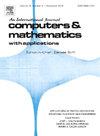A gas-surface interaction algorithm for discrete velocity methods in predicting rarefied and multi-scale flows: For Maxwell boundary model
IF 2.5
2区 数学
Q1 MATHEMATICS, APPLIED
引用次数: 0
Abstract
The discrete velocity method (DVM) for rarefied flows and the unified methods (based on the DVM framework) for flows in all regimes, from continuum one to free molecular one, have worked well as precise flow solvers over the past decades and have been successfully extended to other important physical fields. Both DVM and unified methods endeavor to model the gas-gas interaction physically. However, for the gas-surface interaction (GSI) at the wall boundary, they have only use the full accommodation boundary up to now, which can be viewed as a rough Maxwell boundary with a fixed accommodation coefficient (AC) at unity, deviating from the real value. For example, the AC for metal materials typically falls in the range of 0.8 to 0.9. To overcome this bottleneck and extend the DVM and unified methods to more physical boundary conditions, an algorithm for Maxwell boundary with an adjustable AC is established into the DVM framework. The Maxwell boundary model splits the distribution of the bounce-back molecules into specular ones and Maxwellian (normal) ones. Since the bounce-back molecules after the spectral reflection does not math with the discrete velocity space (DVS), both macroscopic conservation (from numerical quadrature) and microscopic consistency in the DVS are hard to achieve in the DVM framework. In this work, this problem is addressed by employing a combination of interpolation methods for mismatch points in DVS and an efficient numerical error correction method for micro-macro consistency. On the other hand, the current Maxwell boundary for DVM takes the generality into consideration, accommodating both the recently developed efficient unstructured velocity space and the traditional Cartesian velocity space. Moreover, the proposed algorithm allows for calculations of both monatomic gases and diatomic gases with internal degrees in DVS. Finally, by being integrated with the unified gas-kinetic scheme within the DVM framework, the performance of the present GSI algorithm is validated through a series of benchmark numerical tests across a wide range of Knudsen numbers.
用于预测稀薄和多尺度流动的离散速度法的气体-表面相互作用算法:用于麦克斯韦边界模型
过去几十年来,用于稀薄流动的离散速度法(DVM)和用于从连续流动到自由分子流动等各种流动状态的统一方法(基于 DVM 框架)作为精确的流动求解器发挥了很好的作用,并成功地扩展到其他重要的物理领域。DVM 和统一方法都致力于为气体与气体之间的相互作用建立物理模型。然而,对于壁面边界的气-面相互作用(GSI),迄今为止它们都只使用了全容纳边界,这可以看作是一个粗糙的麦克斯韦边界,其容纳系数(AC)固定为 1,偏离真实值。例如,金属材料的 AC 通常在 0.8 至 0.9 之间。为了克服这一瓶颈,并将 DVM 和统一方法扩展到更多的物理边界条件,我们在 DVM 框架中建立了可调节 AC 的麦克斯韦边界算法。麦克斯韦边界模型将反弹分子的分布分为镜面分子和麦克斯韦(正常)分子。由于光谱反射后的反弹分子与离散速度空间(DVS)不存在数学关系,因此在 DVM 框架中很难实现 DVS 的宏观守恒(来自数值正交)和微观一致性。在这项工作中,通过结合使用 DVS 中错配点的插值方法和高效的数值纠错方法来实现微观-宏观一致性,解决了这一问题。另一方面,目前用于 DVM 的麦克斯韦边界考虑到了通用性,既能容纳最近开发的高效非结构化速度空间,也能容纳传统的笛卡尔速度空间。此外,所提出的算法允许在 DVS 中计算单原子气体和具有内部度数的双原子气体。最后,通过与 DVM 框架内的统一气体动力学方案的集成,本 GSI 算法的性能通过一系列宽范围克努森数的基准数值测试得到了验证。
本文章由计算机程序翻译,如有差异,请以英文原文为准。
求助全文
约1分钟内获得全文
求助全文
来源期刊

Computers & Mathematics with Applications
工程技术-计算机:跨学科应用
CiteScore
5.10
自引率
10.30%
发文量
396
审稿时长
9.9 weeks
期刊介绍:
Computers & Mathematics with Applications provides a medium of exchange for those engaged in fields contributing to building successful simulations for science and engineering using Partial Differential Equations (PDEs).
 求助内容:
求助内容: 应助结果提醒方式:
应助结果提醒方式:


